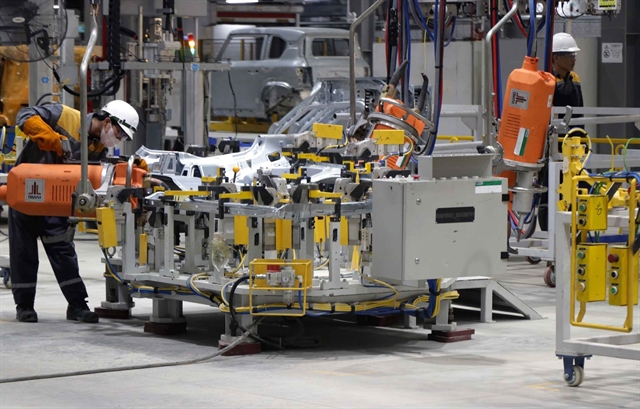 Economy
Economy

" />National Assembly deputies voted to pass the Comprehensive and Progressive Agreement for Trans-Pacific Partnership (CPTPP) at a meeting on Monday afternoon, making Việt Nam became the seventh country to approve the trade deal, following Australia, Japan, Mexico, Singapore, New Zealand and Canada. Economist Võ Trí Thành speaks about the impacts of the CPTPP on Việt Nam as well as the country’s integration landscape.
 |
| Võ Trí Thành |
National Assembly deputies voted to pass the Comprehensive and Progressive Agreement for Trans-Pacific Partnership (CPTPP) at a meeting on Monday afternoon, making Việt Nam became the seventh country to approve the trade deal, following Australia, Japan, Mexico, Singapore, New Zealand and Canada. Economist Võ Trí Thành speaks about the impacts of the CPTPP on Việt Nam as well as the country’s integration landscape.
As an expert who closely watched the progress of the CPTPP, what do you think about the role of the agreement in Việt Nam’s integration progress?
After projections and anticipations of the impacts of the CPTPP on Việt Nam, it’s time for the country to realise these impacts. Of course, along with positive impacts, there are considerable challenges.
But more importantly, Việt Nam’s integration landscape has turned positive, after nearly two years of slowing down, since the US withdrawal from the Trans-Pacific Partnership (TPP) at the beginning of last year and slow progress of the European Union – Việt Nam Free Trade Agreement (EVFTA).
At this time, it is possible that the EVFTA will be signed in the first half of 2019 and take effect soon after.
In comparison to the end of 2015 when the then TPP and EVFTA were being actively promoted, protectionism had not yet taken off and the Regional Comprehensive Economic Partnership was kicked off, integration was not the same. But we have reached a time for action.
Businesses are expecting to immediately benefit from the reduction and removal of tariff lines following commitments between CPTPP country members. What do you think?
Việt Nam can expect to benefit immediately in trade, especially export activities. That is true. However, the increase will not be considerable for countries with which Việt Nam has already signed bilateral or multilateral trade agreements.
For Canada, the impacts will be positive. Canada is the second largest market among CPTPP members and Việt Nam does not have a bilateral trade agreement with this country. Canada commits to cut 94.9 per cent of import tariff lines, or 77.9 per cent of its import turnover from Việt Nam.
For Mexico and Peru, trade is also positive because the import and export products of these two markets are complementary rather than conflicting with Việt Nam.
Investment is more difficult to forecast because the world economy is uncertain and no positive growth is forecast for the coming year. Whether there is a breakthrough in foreign direct investment inflow to Việt Nam or not will depend on the absorption capacity of the economy and the way we call for investments with the target of attracting high-quality capital inflow into sustainable and high-technology projects.
Although the escalating US – China trade war is promoting the China plus one investment trend, we should not be overexcited, given global uncertainties.
What I would like to stress at this moment is the impact on Việt Nam’s reforms and economic restructuring. We must ease disadvantages through continued reforms.
The CPTPP is regarded as a new-generation and high quality trade deal because it not only covers traditional fields such as tariff cuts, opening services markets, intellectual property and trade-related technical barriers but also handles new and non-traditional matters like labour, environment, Government procurement and State-owned enterprises.
Can we expect that after being approved by the National Assembly, the CPTPP will promote restructuring plans in Việt Nam?
My viewpoint is the CPTPP’s impacts on economic restructuring and growth model renovation could be seen from commitments to the institutional and business climate as well as requirements for change.
However, it cannot be said that these requirements would have an immediate impact on the institutional and business climate. Because we have a certain amount of time to implement several commitments. The key point is what we really want to do and how to do it. The efficiency of economic restructuring plans depends more on Việt Nam itself.
What are your recommendations for enterprises and the Government?
There are three points I would like to recommend.
The first is to take advantage of trade emerging when the CPTPP takes effect. In the current situation, demand for diversifying markets is a pressing requirement for enterprises. This is also the way we limit risks and uncertainties from the trade war and protectionism. The Government must play it role in creating mechanisms and policies to promote enterprises seeking new markets.
The second is to take advantage of institutional reforms and policies to increase resilience which contribute to promoting growth and efficiency in Việt Nam. This is also what we are looking for to create a favourable business climate, reduce risks and cut costs for enterprises and investors. Still, enterprises will encounter fiercer competition with new requirements and standards.
The third is, in the long term, that these commitments must be implemented consistently with the overall restructuring of the economy.
Both enterprises and the Government must pay special attention to this. — VNS